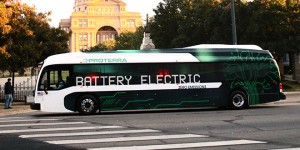 What value does rail transit bring to a city? The bottom line is increased capacity. You can squeeze a lot of people into multiple rail cars, all driven (or overseen) by one conductor in the lead car.
What value does rail transit bring to a city? The bottom line is increased capacity. You can squeeze a lot of people into multiple rail cars, all driven (or overseen) by one conductor in the lead car.
There are other benefits, too, of course, like fast electric acceleration (if it’s not diesel powered), smooth riding (if the rails are in a separate right-of-way and not stuck in street traffic), and general reliability (again, if the rail travels in a separate right-of-way and not slowed by cars). And as a uniquely permanent infrastructure investment, with tunnels and elevated tracks (sometimes) and fixed stations, it can help stimulate real estate investment to encourage thriving, walkable neighborhoods around it.
But technology may make this beloved, nineteenth century style of transit propulsion obsolete. I’m talking about electric platooning buses, which makes use of the self-driving car technology that is rapidly advancing. As the U.S. Department of Energy defined it in a recent post about platooning trucks:
Platooning involves the use of vehicle-to-vehicle communications and sensors, such as cameras and radar, to virtually connect two or more trucks together in a convoy. The virtual link enables all of the vehicles in the platoon to communicate with each other, allowing them to automatically accelerate together, brake together, and enables them to follow each other at a closer distance than is typically possible with unlinked trucks.
If we can place 8 or 10 buses in a row, have them all accelerate electrically and brake together, be separated by just a few inches, and be operated by just a single lead driver (or computer), isn’t this essentially just a long train?
The benefits would be immense:
- Massive cost savings: with electric buses, you don’t need to lay tracks or have overhead or down-below wiring to power trains. You don’t need substations along the way. The buses would be battery operated (as they already are, through companies like BYD and Proterra), so they could charge in central, convenient places. Sure, that requires charging infrastructure. But it’s much less expensive than wiring an entire route.
- Faster build times: transit agencies could build transit lines much more quickly without all the wiring infrastructure and tracks. Tunneling and overpasses still take time, but transit agencies basically just need to put down pavement and striping. Bus rapid transit lines can be built in about a fifth of the time as rail (and at a fifth of the cost), meaning a city can get a lot more transit, a lot more quickly.
- Operational flexibility: the buses would be free to travel on surface streets as needed, giving transit agencies much more flexibility to move buses around as needed.
And the potential downsides? First is the technological uncertainty, as platooning is still being tested. Second, and related to the first point, is the cost and range of the battery. But as I mentioned, electric buses are already being used now, battery prices are falling dramatically, and energy density is improving. True, the buses have higher upfront costs, but they offer significant and offsetting savings on operations and maintenance. Finally, we’d need more charging infrastructure for the buses, as mentioned. Although again, that infrastructure is proven — and simpler than overhead lines or third rails.
But there’s one additional important point here: the prospect of electric platooning buses should not be used as an excuse to kill or postpone new rail transit proposals in the works today. City residents still need the infrastructure that goes with a separate right-of-way for rail, even if the technology changes. They need tunnels, grade separation, elevated lines, dedicated lanes, and overpasses and underpasses to keep rail out of street traffic. Even if platooning electric buses happen soon, that construction will still be put to good use, albeit with ripped out tracks and overhead lines.
But as transit agencies think about other types of rail upgrade projects, like converting the Orange Line bus rapid transit in the San Fernando Valley in Los Angeles into light rail, maybe they should take a step back and assess the state of platooning electric bus technology. That Orange Line project in particular is costly, and the dedicated right-of-way already exists to convert to electric bus. If rail construction is underway in 2020 or 2021 just as electric platooning buses are market-proven, it will be a giant waste of money.
So transit advocates should still want rail projects to move forward, and cities will still need dedicated rights-of-way, separate from car traffic. But looming around the corner may be a technology solution that could dramatically reduce costs and construction time for major transit projects. Even for those who will always love steel wheels on rail, it’s got to be hard not to see the appeal.


